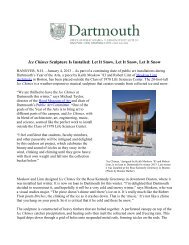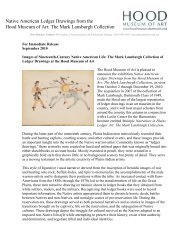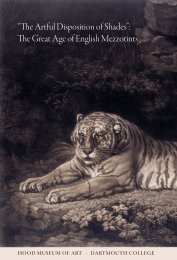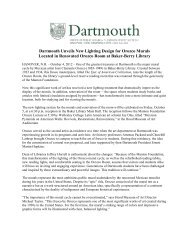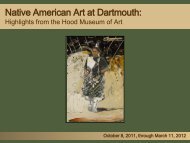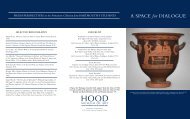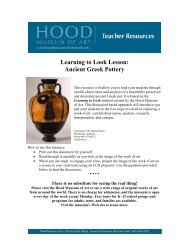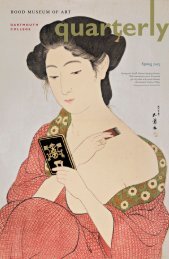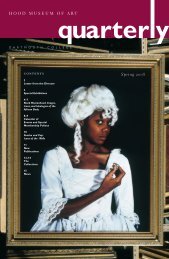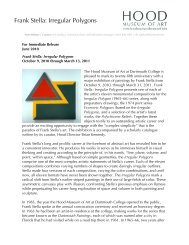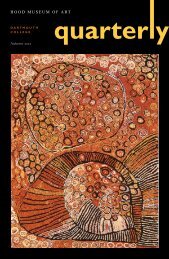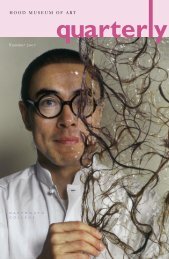Spring 2012 - Hood Museum of Art - Dartmouth College
Spring 2012 - Hood Museum of Art - Dartmouth College
Spring 2012 - Hood Museum of Art - Dartmouth College
You also want an ePaper? Increase the reach of your titles
YUMPU automatically turns print PDFs into web optimized ePapers that Google loves.
RECENT ACQUISITIONS<br />
Frank Weston Benson, Wooster Farm, North Haven, Maine, 1924<br />
Frank Weston Benson,<br />
Wooster Farm, North<br />
Haven, Maine, 1924,<br />
watercolor over graphite<br />
on wove paper. Gift <strong>of</strong> the<br />
artist’s granddaughter,<br />
Corinne Benson Johnson;<br />
2011.58.<br />
Frank Weston Benson (1862–1951) was midway through his artistic career when he took<br />
up watercolor in 1921, but he adapted to the medium quickly and went on to create a<br />
large body <strong>of</strong> work that won him critical favor and swift sales. In this virtuosic example<br />
he captures the shimmering effects <strong>of</strong> dappled sunlight on his beloved summer home,<br />
Wooster Farm, on the island <strong>of</strong> North Haven in Penobscot Bay, Maine. Benson purchased<br />
the property and its large, late-eighteenth-century house in 1901. He had by then<br />
established himself as an influential instructor at Boston’s <strong>Museum</strong> School and as a<br />
leading figure in the so-called Boston school—an informal circle <strong>of</strong> painters known for<br />
their images <strong>of</strong> genteel women set in elegantly appointed rooms. Summer holidays in<br />
Maine <strong>of</strong>fered him a welcome opportunity to paint outdoors—in both watercolor and<br />
oil—in a freer, more spontaneous manner than he typically adopted for his interiors.<br />
In this work Benson first lightly indicated essential outlines in graphite, then applied<br />
both thin swaths and thick dabs <strong>of</strong> watercolor to further convey form, color, and the<br />
flickering effects <strong>of</strong> light and shadow. Reserves <strong>of</strong> the bright white paper provide the<br />
composition’s brilliant highlights. Using a low vantage point, he cropped the top portion<br />
<strong>of</strong> the house, thereby accentuating the broadly handled foreground and giving the<br />
image a greater sense <strong>of</strong> immediacy. Passed down through the artist’s family, this watercolor<br />
is imbued with rich personal associations. Benson frequently painted family members<br />
seated on the garden bench visible near the doorway and, according to his grandchildren,<br />
he dubbed the tree in the left foreground the “banana tree.” He would attach<br />
newly purchased, green bananas to its branches, to be “picked” when ripe.<br />
Man Ray, Mathematical Object, 1934–36<br />
Man Ray (1890–1976), a pioneering American modernist associated with dada and surrealism,<br />
captured this image as part <strong>of</strong> a photographic series he made beginning in 1934 <strong>of</strong><br />
“mathematical objects”—old plaster models <strong>of</strong> algebraic formulae that he encountered<br />
on display in dusty cases in Paris’s Institut Henri Poincaré, named for the highly influential<br />
mathematician who popularized principles <strong>of</strong> relativity and non-Euclidian geometry<br />
(the geometry <strong>of</strong> curved planes). Man Ray appropriated these seemingly sterile objects<br />
based on logic and, through aesthetic choices, animated them and made them his own.<br />
Man Ray, Mathematical<br />
Object, 1934–36, vintage<br />
gelatin silver print.<br />
Purchased through the<br />
Katharine T. and Merrill<br />
G. Beede 1929 Fund;<br />
<strong>2012</strong>.4<br />
Here he enlivens the sculptural form and gives it a monumental presence through<br />
dramatic lighting and close cropping. The deep shadows and brilliant highlights<br />
reflected on its spiraling planes and arcing projections heighten the model’s evocation<br />
<strong>of</strong> a sensual, androgynous figure, capable <strong>of</strong> movement. Man Ray asserted that “the<br />
formulas accompanying [these models] meant nothing to me, but the forms themselves<br />
were as varied and authentic as any in nature.” He was no doubt drawn to their conical,<br />
ovoid, and spiraling shapes, which echoed the geometric underpinnings <strong>of</strong> cubism and<br />
the biomorphic forms favored by Man Ray and other surrealists. The unadorned plaster<br />
construction <strong>of</strong> these models likely also appealed to him and his artistic cohorts, who<br />
favored that inexpensive, white medium for their sculptures and surrealist objects. In<br />
this example we see Man Ray recognizing the aesthetic, intellectual, and mysterious<br />
qualities <strong>of</strong> a non-art object born <strong>of</strong> logic and, through appropriation and aesthetic<br />
choices, presenting it as his own, sensuous work, rich with visual and intellectual<br />
associations.<br />
12



